ecobee smart thermostat
Informing the design of ecobee’s award-winning Smart Thermostat Premium
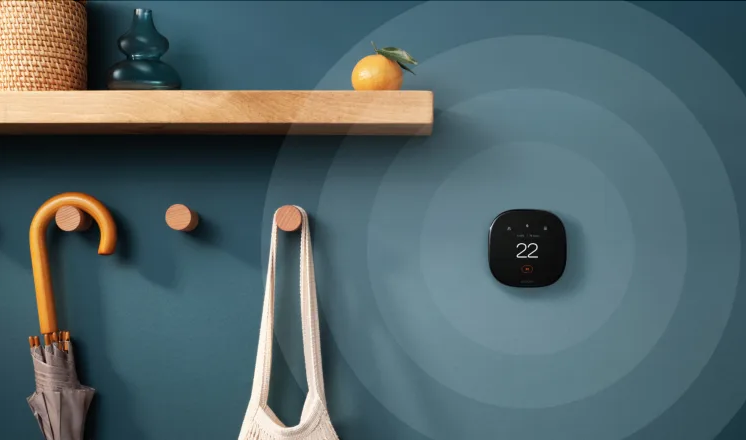
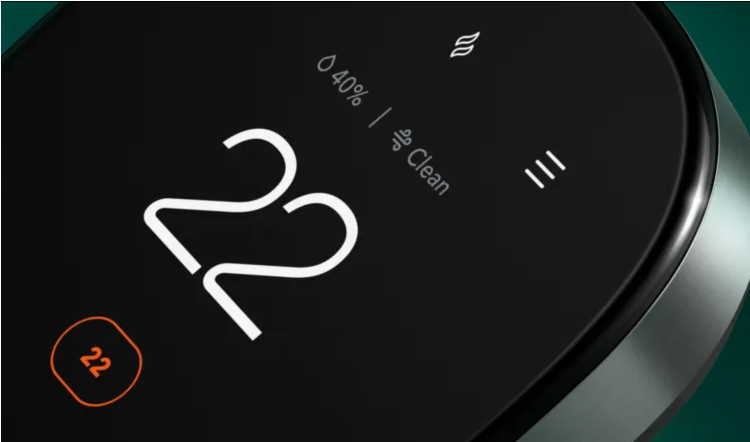
Scope of work
Goal: Understand the thoughts, feelings and preferences of our target audience when it comes to smart thermostat design elements.
Research Approach: Problem discovery, impression testing, preference testing
Role: Planning, recruiting, moderating, synthesizing and reporting
Timeframe: Four weeks
Methods: Focus group, Questionnaire
Tools: UserInterviews, DoveTail
Project Background
ecobee is a Canadian home automation company that designs smart thermostats, cameras, and sensors that work together to monitor the comfort and safety of those in the home.
In 2019, ecobee began planning for a new smart thermostat device with the goal of ‘winning on design’ – meaning that the company wanted to refine and optimize the aesthetic aspects of the thermostat to better reflect the ecobee brand and compete against competitors such as Nest.
“The Nest isn’t the best all-around thermostat, but plenty of people (myself included) have overlooked its shortcomings and added the product to their home because of its thoughtful design.”
– Megan Wollerton, CNET Review
The challenge
Why did prospective customers choose Nest and other brands over ecobee? What was it about the design that drew them in?
The thermostat team had some hunches, but knew that they needed to hear directly from smart thermostat owners and prospective customers if they were serious about ‘winning on design’.
With these goals in mind, the thermostat team asked for my help in:
Understanding the thoughts, feelings and preferences of customers when it comes to smart thermostat design elements
Identifying common product appearance attributes that could then be used as guidelines during briefings at the beginning of the industrial design process
my approach
After an initial kick-off meeting to better understand goals and desired outcomes, I proposed and got alignment on the following research plan:
Research Questions
Aesthetic: What specific design elements are desired with each thermostat?
Symbolic: What thoughts come to mind with each thermostat?
Ergonomic: What specific ergonomic factors are desired with each thermostat?
Functional: What specific aspects of the thermostat interface are desired?
Methodology
90-minute in-person focus groups, covering:
Problem Discovery: Identify needs and desires as it relates to smart thermostat purchasing decisions.
Impression testing: Identify what specific design elements customers like and dislike.
Preference testing: Identify which smart thermostat design customers prefer and why.
Recruitment
16 x Current smart thermostat owners who have purchased a smart thermostat in the last 90 days.
16 x Prospective smart thermostat customers have indicated that they going to be purchasing a smart thermostat in the next 90 days.
Methodology deep dive
I chose to conduct 90-minute focus groups over other research methods as it enabled me to capture feedback from a large number of participants in a shorter amount of time. Through the focus group, I was able to also:
Capture multiple perspectives and discuss any disagreements between participants.
Capture and measure reactions to the physical nature of different smart thermostat devices (e.g. weight, style, size, colour, etc.)
Enable and encourage participants to feed off the opinions and perceptions of others in the room.



Recruitment & Screening
I recruited focus group participants via UserInterviews and screened them based on the following criteria:
Smart thermostat ownership
Purchasing drivers
Demographics
Home ownership and housing type
Participants were segmented into two distinct groups based on smart thermostat ownership to ensure that participants had something in common with each other.
| Audience | Day One | Day Two | Total |
|---|---|---|---|
| Smart thermostat owners | 8 | 8 | 16 |
| Prospective smart thermostat owners | 8 | 8 | 16 |
Notes on recruitment
Participants were not made aware that the focus group study was being conducted by ecobee in order to reduce feedback bias.
An equal distribution of age, gender, ethnicity and income was planned for each session to ensure diversity of feedback.
Eight participants were recruited for each session, to better manage group discussions and ensure that each participant had equal “talk-time”.
research setup and execution
Problem Discovery
As part of the overall discovery process, participants were required to complete a short homework assignment prior to attending their focus group session.
The homework assignment was used to capture additional information on each participant such as their behaviours, attitudes, needs and lifestyle – details about themselves that they may not be as comfortable sharing in a focus group setting.
Collected homework assignments were then used as “profiles” for each participant attending the focus group. This helped me better understand and bring context to feedback shared in the focus group and helped add a layer of richness and depth within the final report.
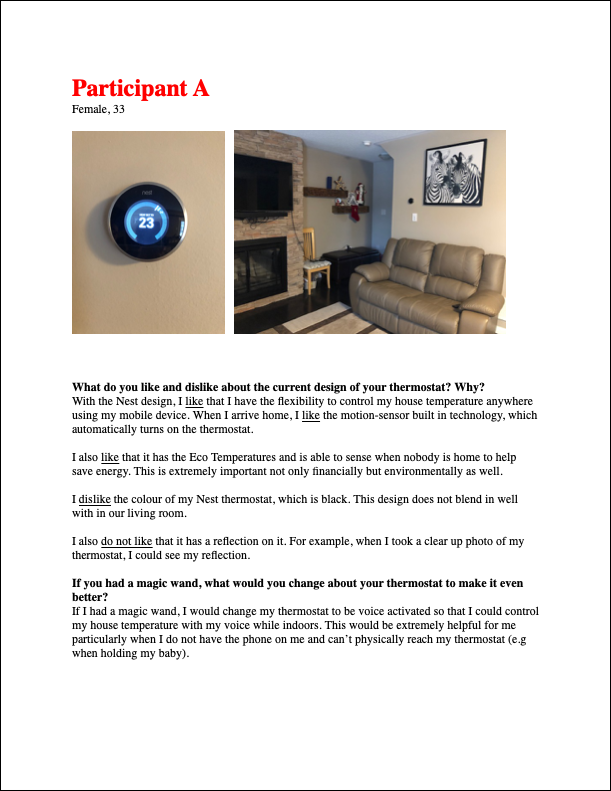
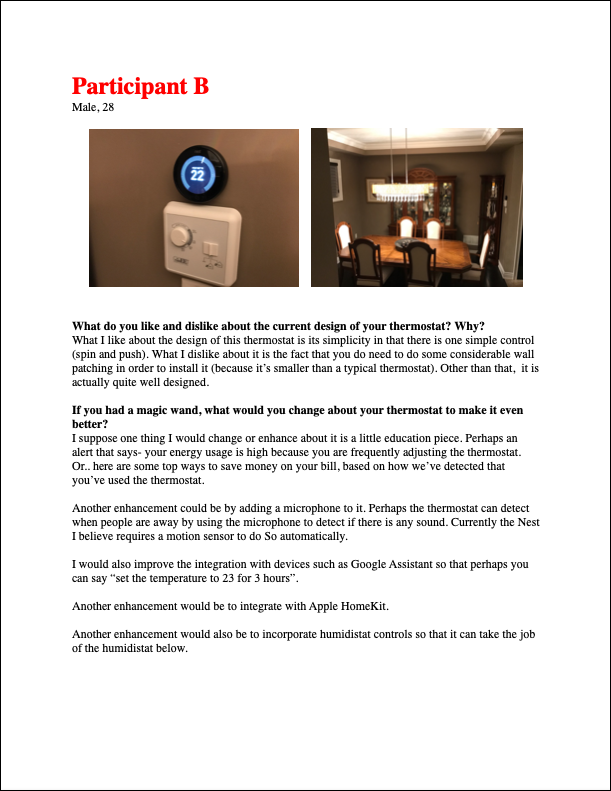

Impression Testing
The first half of the focus group utilized impression testing to capture feedback on the following smart thermostat devices:

The thermostats were mounted side-by-side on a wall and obscured by box cover. I would then reveal a thermostat and give participants two minutes to physically view and interact with it. Afterwards, participants were asked to evaluate the thermostat via a short questionnaire.
The questionnaire required participants to provide a rating on design aspects of the thermostat. Once completed, I moderated a discussion to capture qualitative feedback on the ratings prescribed to each thermostat.
I opted to include questionnaires as part of the focus group research as it:
Helped focus the discussion around specific themes
Eliminated groupthink by ensuring participants are speaking to the reasons for their individual ratings
Made it easier for others to share differing opinions and view points based on their own ratings
Allowed me to strengthen the reporting process by triangulating qualitative feedback with quantitative data

Preference Testing
The second half of the focus group utilized preference testing to identify the thermostat participants felt delivered on specific design criteria. Participants were first asked to make their selections via questionnaire, which was then followed by a group discussion.
Key questions that were asked during the preference testing phase of the focus group include:
Which thermostat is most visually appealing/unappealing?
Which thermostat colour scheme and materials is most attractive/least attractive?
Which thermostat would they want to have on their wall?
Which thermostat looks like the easiest/hardest to control?

mixed method Reporting
The qualitative feedback and individual questionnaires from the focus group sessions were then combined and triangulated to create a series of insight scorecards.
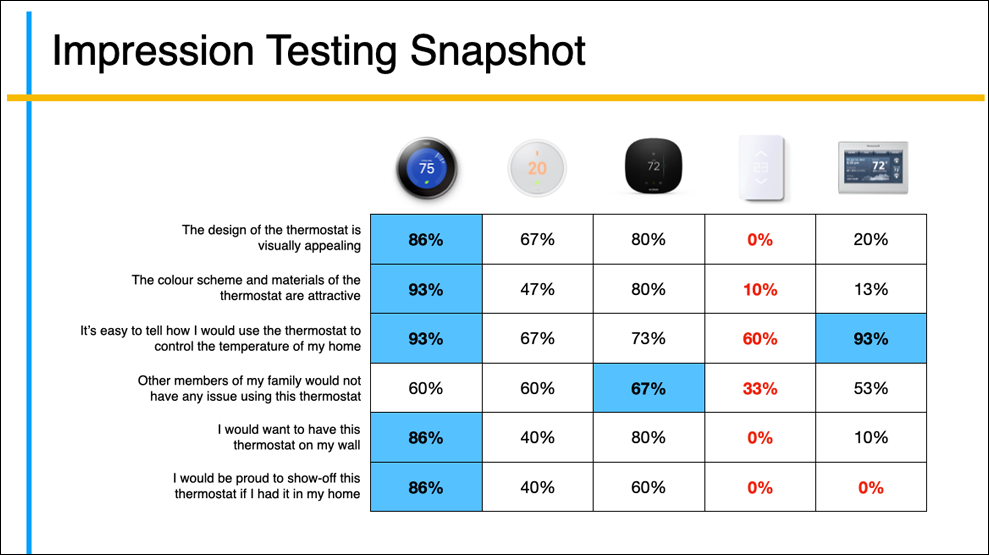

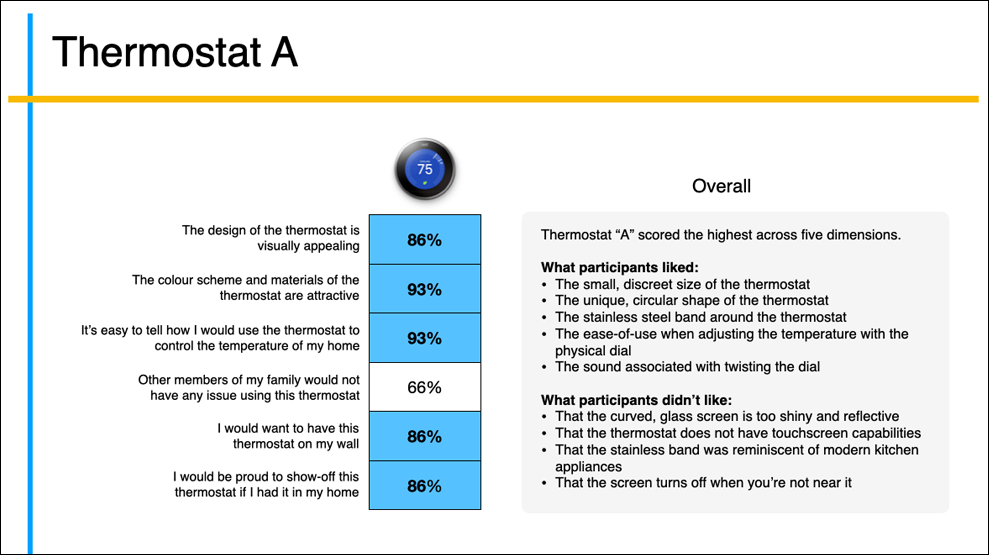
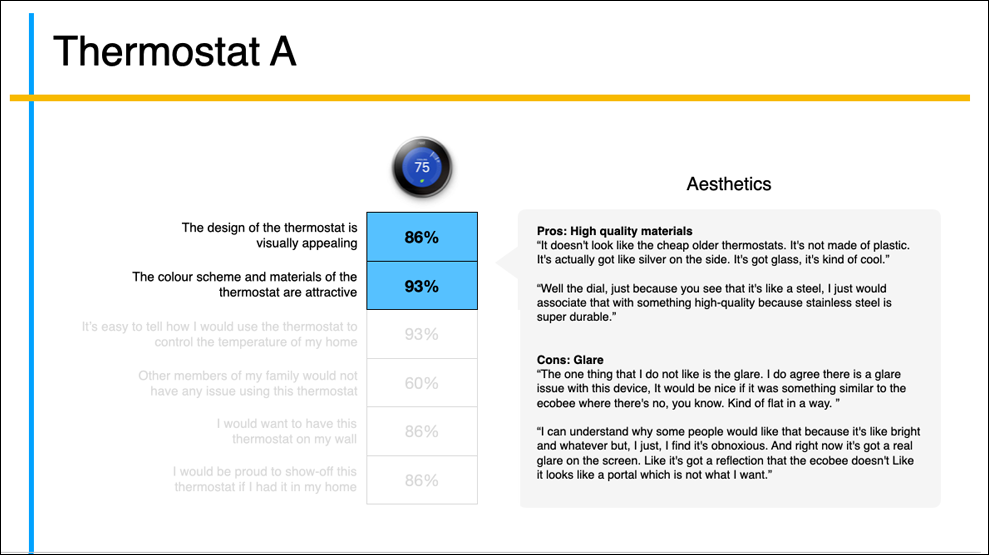
Each scorecard displayed the aggregate ratings for each thermostat along with a summary of key insights and learnings.
I created insight scorecards as part of the reporting process as it:
Provided a simplified top-down view of collected data and insights
Made it easier for stakeholders to quickly identify which thermostat performed the best across key design-related attributes
Increased the validity of insights and learnings by combining both qualitative and quantitative data
Outcome
As a result of the research findings, the ecobee thermostat team had clear direction on the specific hardware design elements that needed to be optimized. Updates to the design include:
Replacing the plastic backing with metal
Increasing the touch screen display by 50%
Introducing a glass face and smooth waterfall edges
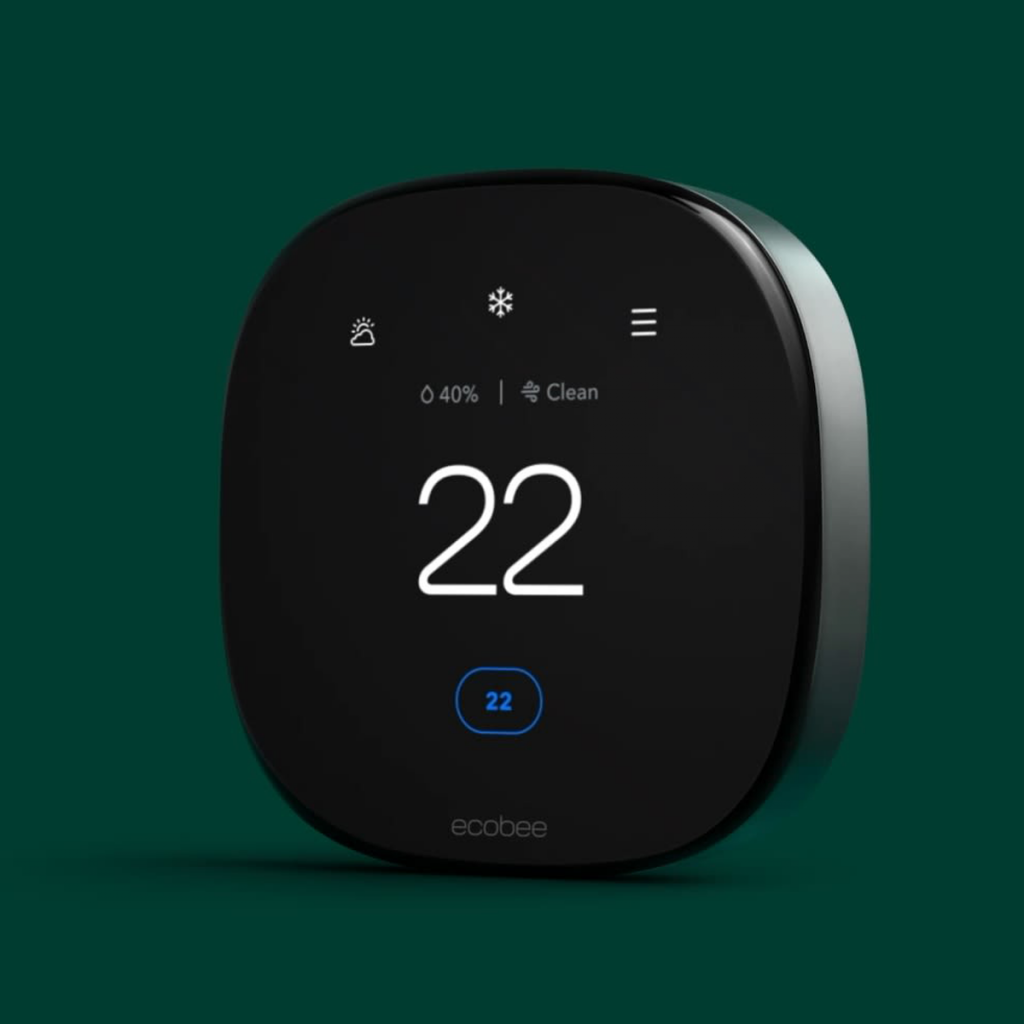
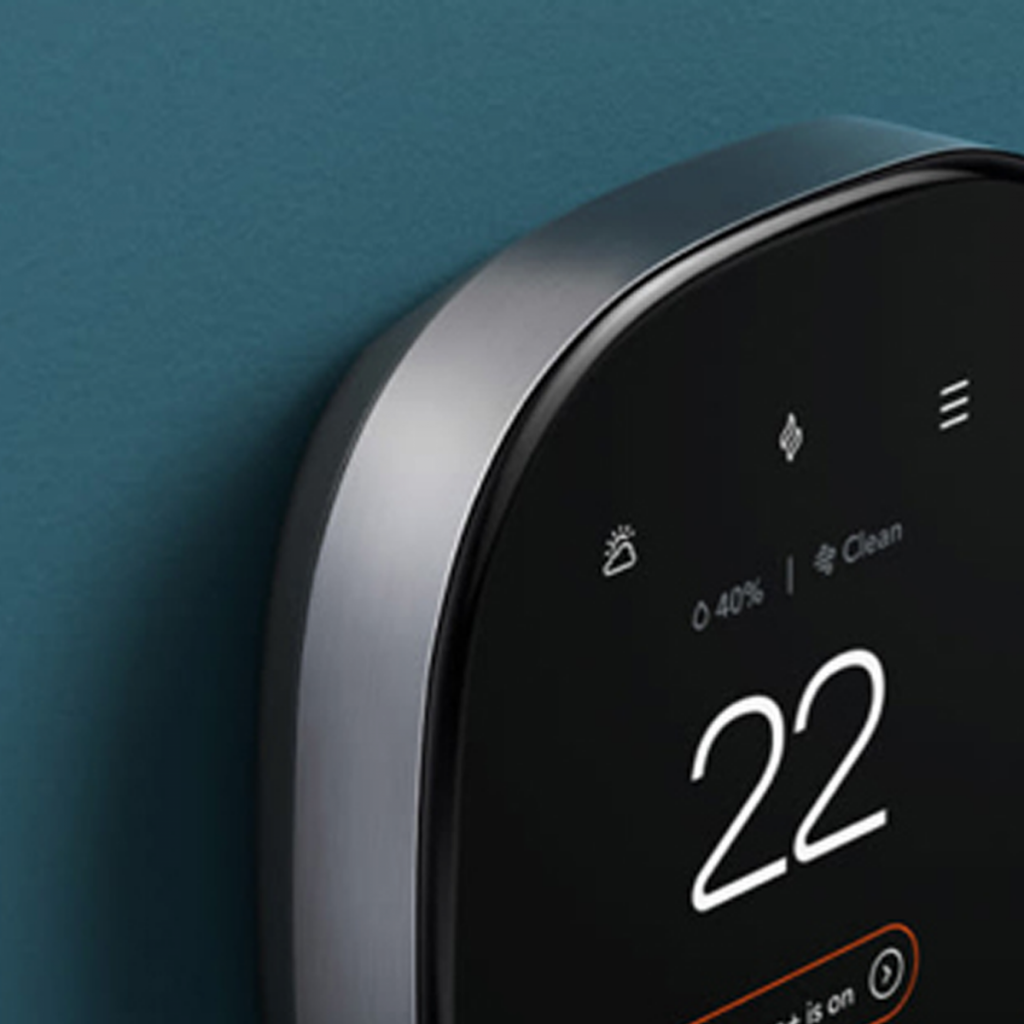
These changes resulted in the team meeting their goal of ‘winning on design’, and in 2022, the newly-designed smart thermostat received the following awards and recognition:
Named one of TIME’s Best Inventions of 2022
Selected as the Best Smart Thermostat of 2022 by Wirecutter
“The ecobee Smart Thermostat Premium immediately feels like an evolution of the design. The new materials, including the zinc body and glass front, all compliment a much more refined UI that brings the control of your house’s temperature to the forefront of the experience.”
– Brendan Frye, CGMagazine
